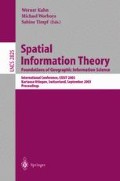Abstract
Spatial agents often have to infer global knowledge from local knowledge about orientations and distances. Thereby, the local knowledge based on sensor data is typically imprecise. We propose an approach that propagates orientation and distance intervals to produce global knowledge and compare it with qualitative reasoning calculi in the context of indoor mobile robot exploration. We combine this propagation method with a path-based and predominantly topological mapping approach and demonstrate how it can be utilized to solve the cycle detection problem.
Access this chapter
Tax calculation will be finalised at checkout
Purchases are for personal use only
Preview
Unable to display preview. Download preview PDF.
References
Clementini, E., Di Felice, P., Hernandez, D.: Qualitative represenation of positional information. Artificial Intelligence 95, 317–356 (1997)
Cohn, A.G.: Qualitative spatial representation and reasoning techniques. In: Brewka, G., Habel, C., Nebel, B. (eds.) KI 1997. LNCS, vol. 1303, pp. 1–30. Springer, Heidelberg (1997)
Cui, Z., Cohn, A.G., Randell, D.A.: Qualitative and topological relationships in spatial databases. In: Abel, D.J., Ooi, B.-C. (eds.) SSD 1993, vol. 692, pp. 296–315. Springer, Heidelberg (1993)
Egenhofer, M.: Reasoning about Binary Topological Relations. In: Günther, O., Schek, H.-J. (eds.) SSD 1991. LNCS, vol. 525, pp. 143–160. Springer, Heidelberg (1991)
Frank, A.: Qualitative spatial reasoning with cardinal directions. In: Proceedings of 7th Os̈terreichische Artificial-Intelligence-Tagung, pp. 157–167. Springer, Berlin (1991)
Freksa, C.: Using Orientation Information for Qualitative Spatial Reasoning. In: Frank, A.U., Campari, I., Formentini, U. (eds.) Theories and Methods of Spatial-Temporal Reasoning in Geographic Space, pp. 162–178. Springer, Berlin (1992)
Isli, A., Cohn, A.: Qualitative spatial reasoning: A new approach to cyclic ordering of 2d orientation. Artificial Intelligence 122, 137–187 (2000)
Isli, A., Moratz, R.: Qualitative Spatial Representation and Reasoning: Algebraic Models for Relative Position. Universität Hamburg, FB Informatik, Technical Report FBI-HH-M- 284/99, Hamburg (1999)
Latombe, J.-C.: Robot Motion Planning. Kluwer, Dordrecht (1991)
Ligozat, G.: Reasoning about cardinal directions. Journal of Visual Languages and Computing 9, 23–44 (1998)
Moratz, R., Renz, J., Wolter, D.: Qualitative spatial reasoning about line segments. In: Horn, W. (ed.) ECAI 2000. Proceedings of the 14th European Conference on Artifical Intelligence, Amsterdam, IOS Press, Amsterdam (2000)
Renz, J., Nebel, B.: On the complexity of qualitative spatial reasoning: A maximal tractable fragment of the region connection calculus. Artificial Intelligence 108(1-2), 69–123 (1999)
Röfer, T.: Route Navigation Using Motion Analysis. In: Freksa, C., Mark, D.M. (eds.) COSIT 1999. LNCS, vol. 1661, pp. 21–36. Springer, Heidelberg (1999)
Scivos, A., Nebel, B.: Double-crossing: Decidability and computational complexity of a qualitative calculus for navigation. In: Montello, D.R. (ed.) COSIT 2001. LNCS, vol. 2205, p. 431. Springer, Heidelberg (2001)
Thrun, S.: Finding landmarks for mobile robot navigation. In: Proceedings IEEE International Conference on Robotics and Automation (ICRA) 1998, pp. 958–963 (1998)
van Zwynsvoorde, D., Simeon, T., Alami, R.: Incremental topological modeling using local voronoi-like graphs. In: IEEE/RSJ Int. Conf. on Intelligent Robots and System (IROS 2000), pp. 897–902 (2000)
Wallgrün, J.O.: Exploration und Pfadplanung für mobile Roboter basierend auf Generalisierten Voronoi-Graphen. Diplomarbeit, Fachbereich Informatik, Universität Hamburg (2002)
Zimmermann, K., Freksa, C.: Qualitative spatial reasoning using orientation, distance, path knowledge. Applied Intelligence 6, 49–58 (1996)
Author information
Authors and Affiliations
Editor information
Editors and Affiliations
Rights and permissions
Copyright information
© 2003 Springer-Verlag Berlin Heidelberg
About this paper
Cite this paper
Moratz, R., Wallgrün, J.O. (2003). Spatial Reasoning about Relative Orientation and Distance for Robot Exploration. In: Kuhn, W., Worboys, M.F., Timpf, S. (eds) Spatial Information Theory. Foundations of Geographic Information Science. COSIT 2003. Lecture Notes in Computer Science, vol 2825. Springer, Berlin, Heidelberg. https://doi.org/10.1007/978-3-540-39923-0_5
Download citation
DOI: https://doi.org/10.1007/978-3-540-39923-0_5
Publisher Name: Springer, Berlin, Heidelberg
Print ISBN: 978-3-540-20148-9
Online ISBN: 978-3-540-39923-0
eBook Packages: Springer Book Archive

